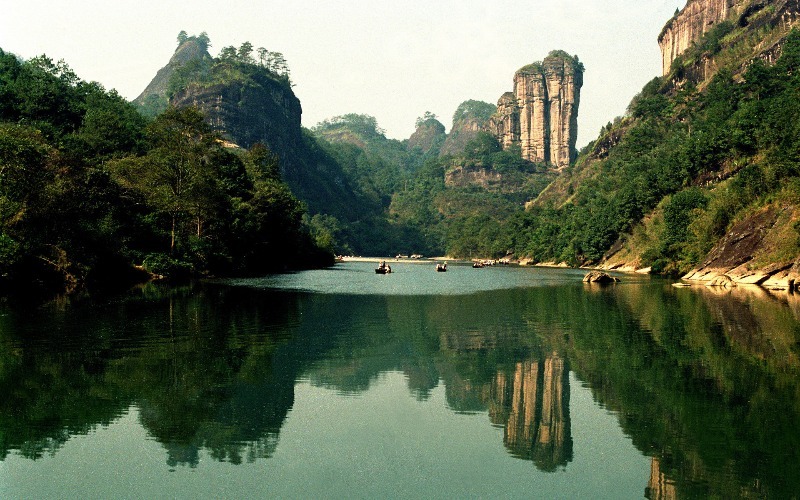Introduction
China is home to some of the most spectacular and diverse landscapes on Earth — soaring snow-capped mountains, vast deserts, pristine rainforests, and untouched grasslands. While many travelers head straight to its megacities or famous landmarks, the real adventure begins in the wilderness discovering the best national parks in china.
For those who crave remote trails, rare wildlife sightings, and the thrill of exploring raw nature, China’s national parks are an emerging paradise. Many of these parks were only officially designated in 2021, but they protect some of the planet’s most fragile ecosystems — and offer adventure travelers a once-in-a-lifetime experience.
In this guide, you’ll discover the best national parks in China for adventure travelers, including where to go, what to expect, and how to plan responsibly.
1. Sanjiangyuan National Park – The Source of Three Great Rivers

Photography from CGTN.
High on the Qinghai-Tibet Plateau, Sanjiangyuan National Park covers nearly 200,000 square kilometers of remote wilderness. Its name means “Source of Three Rivers,” as it shelters the headwaters of the Yangtze, Yellow, and Mekong rivers — the lifelines of Asia.
At an average elevation of 4,700 meters, this is one of the highest ecosystems on Earth. The landscape alternates between frozen peaks, windswept plateaus, and crystal-blue wetlands. It’s also a stronghold for rare wildlife like snow leopards, Tibetan antelope, wild yaks, and black-necked cranes.
Adventure travelers come here not for comfort, but for solitude. Trekking in Sanjiangyuan demands preparation and respect for altitude, but the payoff is immense: untouched scenery, stargazing under thin mountain air, and a feeling of being completely off-grid.
The best time to visit is from May to September, when snow has melted and the air is breathable. Travel usually starts from Xining or Yushu, and local Tibetan guides can arrange eco-friendly tours into the park’s buffer zones.
2. Giant Panda National Park – Trekking Through Bamboo Forests

When most people think of China’s wildlife, the giant panda comes to mind. But few realize they can experience the panda’s natural habitat up close in Giant Panda National Park, a massive protected area that connects 67 separate reserves across Sichuan, Shaanxi, and Gansu provinces.
This park isn’t just about cute faces — it’s an adventure destination wrapped in misty mountains, deep gorges, and dense bamboo forests. Beyond pandas, these mountains are home to red pandas, golden snub-nosed monkeys, and hundreds of bird species.
You can base yourself in Wolong, Dujiangyan, or Tangjiahe, where guided treks and eco-lodges let you explore the forests responsibly. Some reserves even offer volunteer programs focused on panda conservation, allowing travelers to contribute directly to preservation efforts.
The best time to visit is during spring and autumn, when temperatures are mild and the forests glow green. Be prepared for humidity, rain, and steep trails — but also some of the most beautiful landscapes in western China.
3. Hainan Tropical Rainforest National Park – The Call of the Wild

On the southern island of Hainan, tropical humidity replaces alpine chill. Here, the Hainan Tropical Rainforest National Park protects one of the world’s rarest ecosystems — and one of its rarest primates: the Hainan gibbon, with fewer than 40 individuals left.
The park covers over 4,000 square kilometers of lush rainforest, waterfalls, and misty mountains. You’ll find clouded leopards, hornbills, rare amphibians, and giant ferns that look straight out of the Jurassic era.
For adventure travelers, Hainan is paradise. Trekking routes snake through the Bawangling and Diaoluoshan ranges, with eco-lodges allowing access to core zones under guided supervision. Jungle trekking here is humid, intense, and full of life — the kind of sensory overload that reminds you nature is still wild.
The best months to visit are November to April, when the air is drier and the trails less slippery. Bring insect repellent, waterproof gear, and an open mind — this park offers an unforgettable rainforest expedition.
4. Wuyishan National Park – Where Adventure Meets Ancient Tea Culture

Photography from China Highlights.
If you’re searching for a blend of natural beauty, adventure, and culture, Wuyishan National Park in Fujian Province is ideal. Famous for its red sandstone cliffs and winding rivers, it’s one of China’s most photogenic landscapes — and a UNESCO World Heritage Site.
Adventure travelers can hike narrow ridges, climb forested peaks, or raft down the Nine-Bend River on bamboo rafts. The views of mist curling through the valleys are breathtaking, especially at sunrise.
Wuyishan also has deep roots in Chinese tea culture — this is where the world-famous Da Hong Pao oolong tea originates. You can trek through ancient tea terraces, visit traditional villages, and even join tea-picking tours.
Visit between March and November, avoiding the heavy rains of midsummer. Trails vary from easy walks to challenging climbs, making it suitable for both casual explorers and seasoned trekkers.
5. Northeast China Tiger and Leopard National Park – Land of the Big Cats

For pure wildlife adventure, few places in Asia rival the Northeast China Tiger and Leopard National Park. Stretching along the border with Russia and North Korea, this massive wilderness of temperate forest is the last refuge of the Amur tiger and Amur leopard — two of the rarest big cats on Earth.
The park covers nearly 15,000 square kilometers of dense forest, rivers, and snowfields. It’s remote, cold, and untamed — a true frontier. Although spotting a tiger is rare, travelers come for the thrill of being in their domain. Wildlife cameras have captured cubs returning to the wild, a symbol of successful conservation.
Travel here requires planning: winters can plunge below –30°C, and infrastructure is limited. The best season is summer through early autumn, when roads are accessible and the forest teems with life. Guided eco-tours, often led by local rangers or researchers, provide the safest and most ethical way to explore.
6. Other Adventure-Worthy Parks to Consider
Beyond the new national parks, China also offers legendary scenic reserves that double as adventure playgrounds.
-
Jiuzhaigou Valley (Sichuan): Known for turquoise lakes, rainbow-colored pools, and snow-tipped mountains, this UNESCO site is a paradise for photographers and hikers alike.
-
Zhangjiajie National Forest Park (Hunan): The “Avatar Mountains” of China — sandstone pillars rising out of the mist. A must for hikers, climbers, and drone photographers.
-
Changqing Nature Reserve (Shaanxi): Home to golden monkeys, takins, and pandas, this reserve lies in the Qinling Mountains and offers quieter trekking routes away from the crowds.
Each of these destinations combines natural wonder with adventure potential, whether you prefer high-altitude treks or scenic forest walks.
The Rise of China’s National Park System
China’s modern national park system was launched in 2021 with five flagship parks: Sanjiangyuan, Giant Panda, Hainan Rainforest, Wuyishan, and the Northeast Tiger and Leopard Park. This system represents a new era in Chinese conservation — uniting fragmented reserves into large-scale ecosystems managed for both wildlife and sustainable tourism.
The government’s vision is to protect biodiversity while allowing limited, eco-conscious adventure travel. Technology like drones and infrared cameras now monitors wildlife populations, while ranger programs and local community involvement help protect sensitive habitats.
For travelers, this means improved access, better infrastructure in key areas, and a growing number of eco-lodges and guided expeditions. However, many zones remain wild and undeveloped — exactly what makes them so thrilling.
Adventure Travel Tips for Visiting China’s National Parks
Exploring these parks isn’t like visiting a regular tourist spot. You’ll need preparation, respect for local rules, and an adventurous spirit. Here’s how to make the most of your trip:
1. Prepare for Altitude and Weather
High-altitude parks like Sanjiangyuan can cause altitude sickness, even for fit hikers. Acclimatize slowly, drink plenty of water, and listen to your body. Weather conditions can change fast — always pack layers and waterproof gear.
2. Obtain Required Permits
Some regions, especially in Tibet and border areas, require permits or guided access. Always check regulations before you go, as rules may vary depending on conservation zones or seasons.
3. Go With Local Guides
Not only does this support local communities, but it also enhances your safety and understanding of the ecosystem. Many guides are deeply connected to the land and can interpret its wildlife and culture in ways no map can.
4. Respect Wildlife
Keep a respectful distance, use binoculars for viewing, and never feed animals. Ethical wildlife tourism ensures these parks remain pristine for future travelers.
5. Choose the Right Season
Spring (April–June) and autumn (September–October) are generally the best times for most parks, offering mild weather and clear skies. Winter can be magical for snow adventures in the north but requires experience and preparation.
6. Practice Responsible Travel
Follow Leave No Trace principles: pack out your trash, stick to trails, and avoid disturbing cultural sites. Sustainable adventure travel helps maintain the delicate balance between exploration and preservation.
Why Adventure Travelers Shouldn’t Miss China’s Parks
China’s national parks combine three elements that are increasingly rare in the world: vast wilderness, cultural depth, and biodiversity. Few countries can match this combination.
Imagine trekking past nomadic yak herders on the Tibetan Plateau, spotting a red panda in a misty bamboo forest, or hearing the haunting call of a gibbon echo through the rainforest canopy. These are experiences that remind you travel can still feel wild — truly wild.
Moreover, China’s park system is still developing, meaning now is the time to visit before mass tourism takes hold. Many regions remain authentic, uncrowded, and unexplored.
Conclusion
For adventure travelers, China’s national parks represent the ultimate frontier — vast, raw, and full of surprises. From the icy rivers of Sanjiangyuan to the tropical jungles of Hainan, every park offers a different flavor of adventure.
Whether you’re drawn by the call of the snow leopard, the whisper of the rainforest, or the mystery of ancient mountains, these parks will challenge and reward you in equal measure.
Travel here with curiosity, humility, and respect for nature — and you’ll discover a side of China that few outsiders ever see.
Start planning your next China trip today! Click here for a guide on how to do it.







